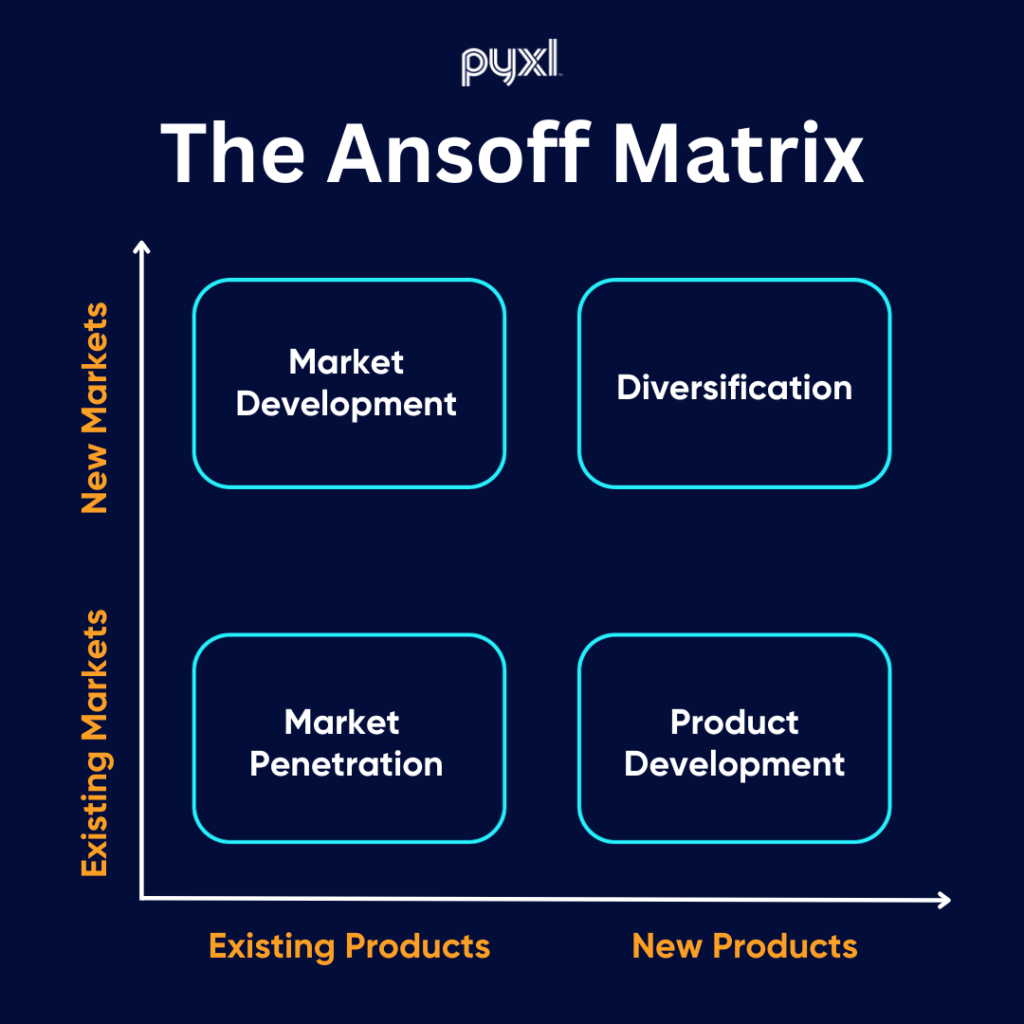Successfully executing new growth strategies can lead to a 77% increase in profitability. However, growth doesn’t just happen; it requires a deliberate approach. A well-thought-out growth strategy is essential to achieve your business expansion objectives and harness this potential.
Let’s explore the vital concept of a growth strategy, supported by 4 real-world growth strategy examples.
In this article:
- Understanding A Growth Strategy
- Examples of Successful Growth Strategies
- Crafting Your Growth Strategy
Understanding Growth Strategy
A growth strategy is a structured plan designed to enhance your market presence. For businesses aiming to scale up, a growth strategy helps define outcomes and considers industry dynamics, target audience, and financial capacity.
The Ansoff Matrix
The Ansoff Matrix provides a concise summary of four primary business growth strategies utilized by top organizations like Meta, Amazon, and Google.
The Ansoff Matrix illustrates the growth strategy in 4 stages:
- Market penetration
- Market development
- Product development
- Diversification

Market Penetration
Within the Ansoff Matrix, market penetration refers to increasing market share within an existing market. Strategies can include price reductions or using tactics like direct marketing to raise awareness of your products or services. You can think of this strategy as brand amplification within your current market.
Market Development
This strategy revolves around exploring new markets with existing products. It could mean targeting a new geographic area (like global expansion), tapping into a new customer demographic, or introducing a new channel, such as initiating an e-commerce platform alongside a physical store.
Product Development
Product development strategy entails introducing new products to existing markets. This can range from an ice cream parlor launching a new flavor to creating an entirely different product line, such as the same parlor venturing into selling pastries.
Diversification
Diversification, a high-risk growth strategy, involves venturing into new markets with new products. It’s uncertain terrain, but the potential rewards can be substantial.
Examples of Successful Growth Strategies
To comprehend how distinct growth strategies operate, let’s examine a few real-world instances.
Market Penetration Example: Coca-Cola
Coca-Cola, renowned worldwide as a leading carbonated soft drink, is a classic example of successful market penetration. Here’s a closer look at how Coca-Cola achieved its status:
- Strong Brand Association: Coca-Cola is recognized for iconic campaigns, like it’s Christmas Santa Claus imagery, making it synonymous with celebrations and major events.
- Aggressive Advertising: From TV ads to billboards, Coca-Cola’s presence is widespread, including product placements in movies and endorsements by celebrities.
- Sporting Event Sponsorships: The brand has a long history with sports marketing, sponsoring leagues and events globally.
- Innovative Campaigns: Campaigns like “Buy the World a Coke” and “Share A Coke” have had a significant global impact.
Coca-Cola’s approach to market penetration involves innovative marketing, demonstrating how a comprehensive strategy can lead to dominance in the global market.
Market Development Example: NBA
The NBA, a leader in professional basketball in the United States, successfully expanded into international markets using a market development growth strategy. Here’s how the NBA achieved this feat:
- Identifying New Markets: The NBA recognized the potential in expanding to international markets, notably China.
- Investing Resources: Significant investments and years of negotiations were dedicated to this expansion.
- Broadcasting Milestone: In 2008, the NBA’s efforts culminated in bringing televised games to China.
- Remarkable Growth: A decade later, the NBA became the most popular sports league in China, with an estimated value exceeding $4 billion.
This strategy demonstrates how identifying and investing in new markets can significantly enhance a brand’s global presence and profitability.
Product Development Example: HubSpot
HubSpot, a leader in marketing and sales automation platforms, exemplifies successful product development at scale. Here’s how HubSpot expanded its product offerings:
- Starting Point: Originally a CRM tool, HubSpot expanded to cater to marketers, salespeople, and customer support.
- Data-Driven Expansion: They used customer data from their CRM to identify expansion opportunities.
- Strategic Focus on Inbound Marketing: HubSpot’s early development was guided by the concept of “Inbound Marketing,” which they coined, influencing their product ecosystem.
- Developing the Flywheel Framework: This approach helped them understand their impact on customers and the business.
- Lean Product Development: They identified customer needs, leading to the development of highly targeted marketing automation tools.
- Platform Expansion: Recognizing the need for a more integrated solution, HubSpot connected its CRM and CMS with automated email, social media, and blogging capabilities, continuing to develop new product lines, features, and communities today
This strategic approach to product development allowed HubSpot to build a comprehensive platform that addresses diverse customer needs, enhancing its market position.
Diversification Growth Strategy Example: The Walt Disney Company
The Walt Disney Company’s journey from an animation studio to a diverse global entertainment powerhouse is a prime example of an effective diversification growth strategy. Here’s how Disney achieved this transformative growth:
- Initial Reputation in Animation: Disney began as an animation and children’s cartoon studio in the early 20th century.
- Expansion through Theme Parks: They launched their first Disney World theme park in 1955, marking the start of their diversification.
- Aggressive Acquisitions: From the 1990s, Disney acquired companies like Miramax Films, ABC, Fox Family, Pixar, Marvel, LucasFilms, and 21st Century Fox, significantly expanding their presence in the entertainment and media industry.
- Modernizing Animation: The acquisition of Pixar exemplified Disney’s strategy to modernize their traditionally hand-drawn animation by acquiring a company with existing expertise. This innovation was a necessary step in order to provide a unique advantage and continue growing in the new areas they were pushing into.
- Ownership of Iconic Brands: Acquiring Marvel and LucasFilm gave Disney control over the merchandising and image rights of globally recognized media brands.
- Expansion into Digital Streaming: The acquisition of 21st Century Fox enhanced Disney’s catalog for its Disney+ streaming service, competing with Netflix, Amazon Prime, and Apple TV.
- Venturing into Family-Friendly Vacations: Disney successfully entered the family vacation market with theme parks, hotel resorts, and cruises.
Disney’s diversification strategy, marked by strategic acquisitions and expansion into new markets, has been pivotal in its transformation into a leading global entertainment company.
Crafting Your Growth Strategy
Having observed how different companies achieved expansion, let’s focus on formulating your growth strategy.
Establish Your Objectives
While revenue growth is usually a priority, ponder on how you can achieve it. Is it through customer acquisition, new products, or modifying pricing?
Outline measurable goals that resonate with your business phase and trajectory. For instance, aim to secure a hundred new clients in the upcoming month.
Set Short Timelines
Your goals should be attainable in a brief period, such as a month or quarter.
Quick timelines ensure agility in planning and adapting to evolving circumstances while continually refining your approach.
Conduct Market Research
Market research is pivotal to validate your growth strategy. Understanding industry trends, competition, and customer behavior is essential.
Develop a Forecasting Model
A forecasting model gauges your growth trajectory and serves as a tool for aligning teams towards your goals. It helps track progress and facilitates communication.
Determine Actionable Steps
Transition from overarching objectives to specific, actionable steps. Identify tactics and tools necessary to realize your growth objectives.
Crafting a growth strategy is vital, but execution is paramount. Utilize your action plan and consistently evaluate your progress against the forecasting model.
Key Takeaways
Being adaptable and ready to pivot is crucial in today’s dynamic business environment. A well-crafted growth strategy can substantially increase your likelihood of scaling your business successfully. It involves not just planning but also the ability to respond to changing market conditions and consumer needs.
Because every business is different and requires custom strategies, partnering with a growth-focused company like Pyxl becomes invaluable. Pyxl specializes in crafting and implementing effective growth strategies tailored to your specific business needs. By working with Pyxl, you gain a partner committed to your growth, providing expertise and support every step of the way. Contact us today to get started!
Updated: Nov 30, 2023
 Taylor Farace
Taylor Farace Kati Terzinski
Kati Terzinski Erin Murray
Erin Murray